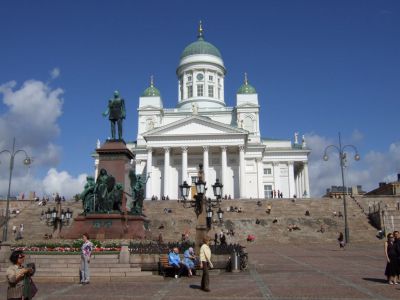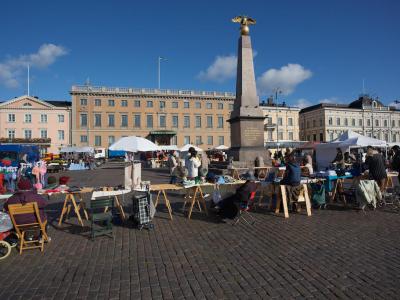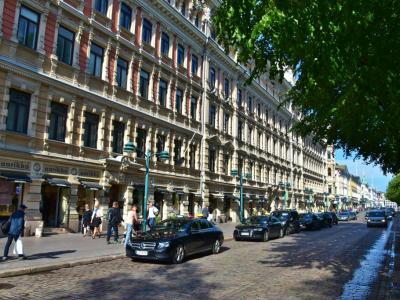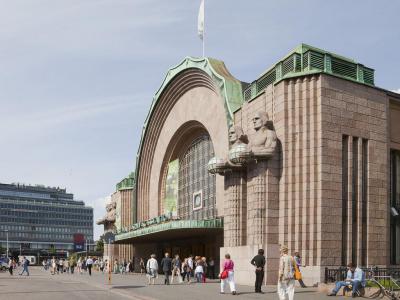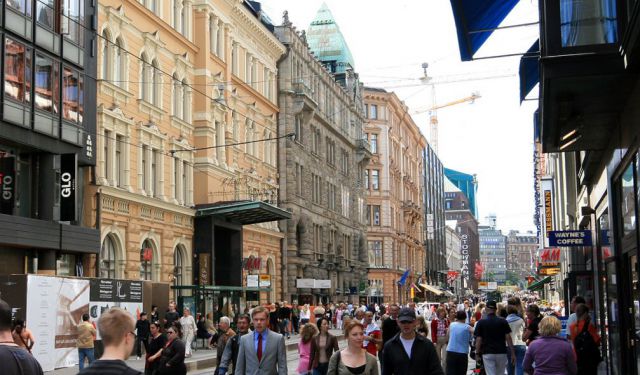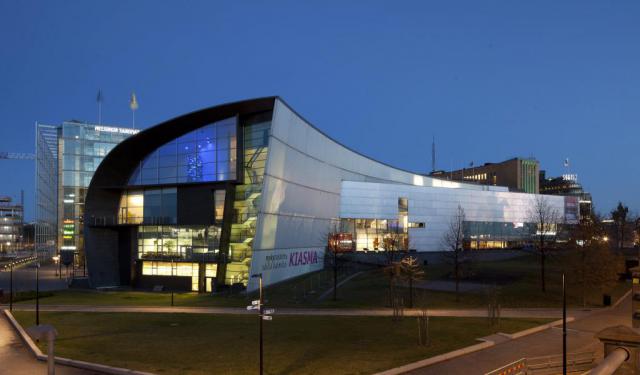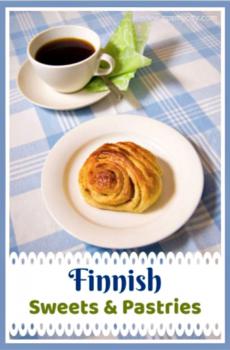
Helsinki Introduction Walking Tour (Self Guided), Helsinki
Helsinki was created as a trading town by Swedish King Gustav I in 1550, but it is believed that Swedish settlers had arrived here in the 1300s. Sometimes called the “Daughter of the Baltic,” Helsinki is a port town through and through. Its close connection to its Baltic neighbors, Sweden and Russia, has shaped its history for better and worse over the last 400 years. Both Finnish and Swedish are official languages, and you will find a statue honoring Russian Tsar Alexander II in the middle of Senate Square.
Helsinki is many things. It is the northernmost city on Earth that has a population of more than a million people. It is the northernmost EU capital, and it is the only metropolis in Finland. In 2012 it was named a World Design Capital, and it is regularly recognized as being one of the world’s most livable cities with one of the highest standards of living anywhere.
Helsinki’s close ties to the Baltic are on clear display for the visitor to the Finnish capital. This city is spread over a large peninsula and 315 islands. Senate Square with the Helsinki Cathedral on it are the city's top attractions. Market Square, another popular site near downtown, lies right on the seafront, and is a spot from where ferries depart to the famous sea fortress of Suomenlinna.
From Market Square, head on to the Old Market Hall to pick up some food for a picnic in the nearby Esplanadi Park. But that’s just the start. You can see all that Helsinki has to offer by taking a self-guided walking tour of this beautiful, friendly, and fabulous Nordic city.
Helsinki is many things. It is the northernmost city on Earth that has a population of more than a million people. It is the northernmost EU capital, and it is the only metropolis in Finland. In 2012 it was named a World Design Capital, and it is regularly recognized as being one of the world’s most livable cities with one of the highest standards of living anywhere.
Helsinki’s close ties to the Baltic are on clear display for the visitor to the Finnish capital. This city is spread over a large peninsula and 315 islands. Senate Square with the Helsinki Cathedral on it are the city's top attractions. Market Square, another popular site near downtown, lies right on the seafront, and is a spot from where ferries depart to the famous sea fortress of Suomenlinna.
From Market Square, head on to the Old Market Hall to pick up some food for a picnic in the nearby Esplanadi Park. But that’s just the start. You can see all that Helsinki has to offer by taking a self-guided walking tour of this beautiful, friendly, and fabulous Nordic city.
How it works: Download the app "GPSmyCity: Walks in 1K+ Cities" from Apple App Store or Google Play Store to your mobile phone or tablet. The app turns your mobile device into a personal tour guide and its built-in GPS navigation functions guide you from one tour stop to next. The app works offline, so no data plan is needed when traveling abroad.
Helsinki Introduction Walking Tour Map
Guide Name: Helsinki Introduction Walking Tour
Guide Location: Finland » Helsinki (See other walking tours in Helsinki)
Guide Type: Self-guided Walking Tour (Sightseeing)
# of Attractions: 9
Tour Duration: 2 Hour(s)
Travel Distance: 3.1 Km or 1.9 Miles
Author: kane
Sight(s) Featured in This Guide:
Guide Location: Finland » Helsinki (See other walking tours in Helsinki)
Guide Type: Self-guided Walking Tour (Sightseeing)
# of Attractions: 9
Tour Duration: 2 Hour(s)
Travel Distance: 3.1 Km or 1.9 Miles
Author: kane
Sight(s) Featured in This Guide:
- Senaatintori (Senate Square)
- Helsinki Cathedral
- Kauppatori (Market Square)
- Vanha kauppahalli (Old Market Hall)
- Esplanadi Park
- Ateneum Art Museum
- Helsinki Central Railway Station
- Kamppi Chapel of Silence
- Temppeliaukio Rock Church
1) Senaatintori (Senate Square) (must see)
Senate Square, or Senaatintori, is a city square surrounded by beautiful Neo-Classical buildings. The square and its buildings are the oldest part of Helsinki. The structures on the square include the Cathedral, the main building of the University of Helsinki, the Government Palace, and the Sederholm House dating from 1757.
The square is built on the site of a 17th and 18th-century graveyard. The city plan, designed by Johan Albrecht Ehrenström, designated the square in 1812. By 1822, the Government Palace was completed. The Senate of Finland met there until the Council of State replaced it in 1918. Today, the building is used by the Prime Minister and Cabinet officials.
The University Building was constructed in 1832. But the most dominant building in the square is by far the Helsinki Cathedral. It was designed by Carl Ludvig Engel but was not completed until 12 years after his death. It was initially called the Church of Saint Nicholas.
Walter Runeberg carved the central statue of Emperor Alexander II in 1894. During the Russian years, the Alexander statue was a symbol of resistance. People would leave flowers under the statue as a gesture of protest against Alexander's grandson, tsar Nicolas II. Alexander was known locally as "the good tsar."
Why You Should Visit:
Today, Senate Square is a popular destination. There's often a festival, art exhibition, or concert going on.
The square is the site of the oldest buildings in Helsinki. The Cathedral is especially worth seeing as it is one of the most iconic buildings in the city. From the stairs to the Cathedral, be sure to take in the view of the city all around.
Tips:
Every day a digital carillon plays at 17:49. The acoustically best spot to hear the piece is at the central statue of Alexander II.
If visiting in the wintertime, the Helsinki Christmas Market is held every December in Senate Square.
The square has appeared in many movies, including many scenes that were supposedly set in Russia. By omitting the distinctive Cathedral from his shots, Warren Beatty convincingly used Senate Square as a substitute for Soviet Saint Petersburg in the 1981 film Reds.
The square is built on the site of a 17th and 18th-century graveyard. The city plan, designed by Johan Albrecht Ehrenström, designated the square in 1812. By 1822, the Government Palace was completed. The Senate of Finland met there until the Council of State replaced it in 1918. Today, the building is used by the Prime Minister and Cabinet officials.
The University Building was constructed in 1832. But the most dominant building in the square is by far the Helsinki Cathedral. It was designed by Carl Ludvig Engel but was not completed until 12 years after his death. It was initially called the Church of Saint Nicholas.
Walter Runeberg carved the central statue of Emperor Alexander II in 1894. During the Russian years, the Alexander statue was a symbol of resistance. People would leave flowers under the statue as a gesture of protest against Alexander's grandson, tsar Nicolas II. Alexander was known locally as "the good tsar."
Why You Should Visit:
Today, Senate Square is a popular destination. There's often a festival, art exhibition, or concert going on.
The square is the site of the oldest buildings in Helsinki. The Cathedral is especially worth seeing as it is one of the most iconic buildings in the city. From the stairs to the Cathedral, be sure to take in the view of the city all around.
Tips:
Every day a digital carillon plays at 17:49. The acoustically best spot to hear the piece is at the central statue of Alexander II.
If visiting in the wintertime, the Helsinki Christmas Market is held every December in Senate Square.
The square has appeared in many movies, including many scenes that were supposedly set in Russia. By omitting the distinctive Cathedral from his shots, Warren Beatty convincingly used Senate Square as a substitute for Soviet Saint Petersburg in the 1981 film Reds.
2) Helsinki Cathedral (must see)
Helsinki Cathedral is an important symbol of Finnish culture and architecture, situated in the heart of Helsinki's Kruununhaka neighborhood on Senate Square. This impressive building serves as the main Lutheran cathedral for the Diocese of Helsinki and has a rich history dating back to the early 19th century. Initially built between 1830 and 1852, the cathedral was dedicated to the Grand Duke of Finland, Tsar Nicholas I, and was known as Saint Nicholas's Church until Finland gained independence in 1917. Today, it is renowned worldwide as one of Finland's most significant historical landmarks.
Designed by Carl Ludvig Engel in the Neoclassical style, Helsinki Cathedral features a distinctive green dome surrounded by four smaller domes, creating a striking silhouette against the city skyline. Engel intended the cathedral to be the focal point of his design for Senate Square, with other structures complementing its grandeur. The cathedral's architectural plan, based on a Greek cross, emphasizes symmetry with colonnades and pediments adorning each arm, though Engel's original vision for additional columns at the entrance was never realized.
Built on the site of the earlier Ulrika Eleonora Church from the 18th century, Helsinki Cathedral's foundation has historical significance. Construction was funded by a decree from Alexander I, tying its origins to Helsinki's designation as the nation's capital in 1812. While Engel passed away before its completion, Ernst Lohrmann, his successor, made further contributions to the design, including the addition of four small domes and a bell tower. Notable zinc statues of the Twelve Apostles, crafted by renowned artists of the time, adorn the roofline.
Throughout its existence, Helsinki Cathedral has undergone renovations and restorations, including the conversion of its crypt into a functional space for exhibitions and events beyond religious ceremonies. It remains an important center for worship, hosting regular services and special occasions like weddings. With half a million visitors in 2018 alone, it is a popular tourist destination, embodying Finnish culture and spirituality through its historical significance, architectural grandeur, and active community involvement.
Tips:
Plenty of steps to get to the cathedral's main entrance (no handrails, so be prepared). There are some wheelchair ramps if needed.
Also worth a visit is an atypical café right under the cathedral (Cafe Krypta). The entrance is at the back of Kirkkokatu Street or via elevator from the cathedral. Friendly staff, delicious pastries, and inexpensive coffee.
Designed by Carl Ludvig Engel in the Neoclassical style, Helsinki Cathedral features a distinctive green dome surrounded by four smaller domes, creating a striking silhouette against the city skyline. Engel intended the cathedral to be the focal point of his design for Senate Square, with other structures complementing its grandeur. The cathedral's architectural plan, based on a Greek cross, emphasizes symmetry with colonnades and pediments adorning each arm, though Engel's original vision for additional columns at the entrance was never realized.
Built on the site of the earlier Ulrika Eleonora Church from the 18th century, Helsinki Cathedral's foundation has historical significance. Construction was funded by a decree from Alexander I, tying its origins to Helsinki's designation as the nation's capital in 1812. While Engel passed away before its completion, Ernst Lohrmann, his successor, made further contributions to the design, including the addition of four small domes and a bell tower. Notable zinc statues of the Twelve Apostles, crafted by renowned artists of the time, adorn the roofline.
Throughout its existence, Helsinki Cathedral has undergone renovations and restorations, including the conversion of its crypt into a functional space for exhibitions and events beyond religious ceremonies. It remains an important center for worship, hosting regular services and special occasions like weddings. With half a million visitors in 2018 alone, it is a popular tourist destination, embodying Finnish culture and spirituality through its historical significance, architectural grandeur, and active community involvement.
Tips:
Plenty of steps to get to the cathedral's main entrance (no handrails, so be prepared). There are some wheelchair ramps if needed.
Also worth a visit is an atypical café right under the cathedral (Cafe Krypta). The entrance is at the back of Kirkkokatu Street or via elevator from the cathedral. Friendly staff, delicious pastries, and inexpensive coffee.
3) Kauppatori (Market Square) (must see)
On the Baltic Sea at the eastern end of the Esplanadi Park likes Market Square. Many local cruises and sightseeing boats depart from the port next to the square in the summer, including the year-round ferry to Suomenlinna Sea Fortress. Many vendors congregate here to sell souvenirs and fresh fish and seafood. Cafes are dotted around the square, and it's a great place to grab a lihapiirakka, a Finnish meat pastry.
The square is the site of the famous annual herring market in October. Many popular sites are located next to Market Square, including the Presidential Palace, Swedish Embassy, and the Helsinki City Hall. The square is a beautiful place to stroll, and the ships in the harbor and vendors selling their goods will take you back to a bygone era.
On the south side of the square, look for the Vanha Kauppahalli, or Old Market Hall. This is a popular shopping spot and a great place to sample local delicacies.
Why You Should Visit:
Fun place to get a taste of Finnish food and try something you haven't eaten before.
Tip:
Do not leave without trying the "neulamuikut" (deep fried whitefish), which is usually served with potatoes and garlic sauce. If you visit when the season for wild berries & mushrooms starts, stop by to stock on some fresh wonderful cloudberries or chanterelles.
The square is the site of the famous annual herring market in October. Many popular sites are located next to Market Square, including the Presidential Palace, Swedish Embassy, and the Helsinki City Hall. The square is a beautiful place to stroll, and the ships in the harbor and vendors selling their goods will take you back to a bygone era.
On the south side of the square, look for the Vanha Kauppahalli, or Old Market Hall. This is a popular shopping spot and a great place to sample local delicacies.
Why You Should Visit:
Fun place to get a taste of Finnish food and try something you haven't eaten before.
Tip:
Do not leave without trying the "neulamuikut" (deep fried whitefish), which is usually served with potatoes and garlic sauce. If you visit when the season for wild berries & mushrooms starts, stop by to stock on some fresh wonderful cloudberries or chanterelles.
4) Vanha kauppahalli (Old Market Hall) (must see)
The Old Market Hall in Helsinki has a special significance in the city's business and cultural life. It's the oldest among Helsinki's market halls, opening its doors to the public back in 1889. This architectural marvel came during a time when Helsinki was moving from chaotic open-air markets to more organized indoor setups. Concerns about food hygiene and the need for structured trading spaces drove this transition away from the haphazard market squares of the 19th century.
Construction of the Old Market Hall began in 1888, led by Gustaf Nyström, who had experience designing market halls across Europe. However, delays due to issues with the cement supply pushed its opening to a year later. Nyström aimed for a design that combined functionality with aesthetic appeal, creating a sophisticated trading environment. The hall proudly displays the year of its opening at its southern end, underscoring its historical significance.
Situated next to the Helsinki Market Square, the Old Market Hall adds richness to the city's culinary offerings. It's a paradise for food lovers, hosting various vendors selling cheeses, fish, shellfish, meats, fruits, vegetables, and spices, as well as coffee, tea, small gifts, and tableware. It even houses Finland's smallest Alko store, enhancing its uniqueness.
Beyond being a shopping destination, the Old Market Hall offers culinary experiences, renowned for its delicious salmon soup and fish sandwiches that draw visitors from afar. It's also a convenient stop for lunch, especially for those heading to Suomenlinna, as the ferry departure point is nearby at the Helsinki Market Square.
Why You Should Visit:
Amazing selection of food and drinks and a great place to pick up a couple of presents to take home. If you're a fish lover, especially salmon, you have to visit as there are lots of different types to try. If you are more of a meat lover, there are stalls selling reindeer burgers/kebabs which are worth tasting.
Construction of the Old Market Hall began in 1888, led by Gustaf Nyström, who had experience designing market halls across Europe. However, delays due to issues with the cement supply pushed its opening to a year later. Nyström aimed for a design that combined functionality with aesthetic appeal, creating a sophisticated trading environment. The hall proudly displays the year of its opening at its southern end, underscoring its historical significance.
Situated next to the Helsinki Market Square, the Old Market Hall adds richness to the city's culinary offerings. It's a paradise for food lovers, hosting various vendors selling cheeses, fish, shellfish, meats, fruits, vegetables, and spices, as well as coffee, tea, small gifts, and tableware. It even houses Finland's smallest Alko store, enhancing its uniqueness.
Beyond being a shopping destination, the Old Market Hall offers culinary experiences, renowned for its delicious salmon soup and fish sandwiches that draw visitors from afar. It's also a convenient stop for lunch, especially for those heading to Suomenlinna, as the ferry departure point is nearby at the Helsinki Market Square.
Why You Should Visit:
Amazing selection of food and drinks and a great place to pick up a couple of presents to take home. If you're a fish lover, especially salmon, you have to visit as there are lots of different types to try. If you are more of a meat lover, there are stalls selling reindeer burgers/kebabs which are worth tasting.
5) Esplanadi Park (must see)
Between Erottaja Square and Market Square, you will find Esplanadi Park. Known simply as ‘Espa’ by the locals, this long promenade is a popular walking area. The park opened in 1818 and was designed by Carl Ludwig Engel. In 1827, Engels Teater was the first theater built in Helsinki.
Espa is a popular spot with locals to enjoy a picnic or see live performances. The central section of the park features roses bushes, crab apple trees, and aspen trees. You'll see many monuments and statues, including one of national poet Johan Ludvig Runeberg. He wrote the Finnish national anthem, and his was the first monument erected in Helsinki in 1885.
The Kappeli Restaurant opened in 1867, and it’s still known for great food in a beautiful setting. Espa Stage hosts live music throughout the year, including the longest music festival in Finland. It's held from May until the end of August and features 200 or more artists hosted by the Cultural Office of the City of Helsinki.
Why You Should Visit:
Beautiful open space in the middle of the city, great for sitting on the bench and people watching, or bringing food and having a picnic.
Tip:
Be sure to take in the architecture on both sides – the old buildings are splendid.
Espa is a popular spot with locals to enjoy a picnic or see live performances. The central section of the park features roses bushes, crab apple trees, and aspen trees. You'll see many monuments and statues, including one of national poet Johan Ludvig Runeberg. He wrote the Finnish national anthem, and his was the first monument erected in Helsinki in 1885.
The Kappeli Restaurant opened in 1867, and it’s still known for great food in a beautiful setting. Espa Stage hosts live music throughout the year, including the longest music festival in Finland. It's held from May until the end of August and features 200 or more artists hosted by the Cultural Office of the City of Helsinki.
Why You Should Visit:
Beautiful open space in the middle of the city, great for sitting on the bench and people watching, or bringing food and having a picnic.
Tip:
Be sure to take in the architecture on both sides – the old buildings are splendid.
6) Ateneum Art Museum (must see)
On Rautatientori square, close to the Helsinki Central rail stations, lies Ateneum. It is one of three museums that form the Finnish National Gallery. The other two are the Kiasma Museum of Contemporary Art and the Sinebrychoff Art Museum.
The museum gallery focuses on Finnish art from the 18th to the 20th centuries. There are also 650 or so international works, including one piece by Vincent van Gogh.
The building was designed by Theodor Höijer and built in 1887. The heavily ornamented exterior includes busts of famous artists like Raphael. Four female figures support the pediment, each representing one of the four classical art forms—architecture, painting, sculpture, and geometry. Above, the Goddess of Art, Pallas Athene, blesses the artworks.
Ateneum has rotating exhibitions in addition to their permanent collection, and they offer Saturday workshops with museum admission. The gallery is closed on Mondays. There's a museum shop on the property as well.
Why You Should Visit:
One of the best art museums in the Nordics, and certainly recommendable if you want to have a look at the most famous Finnish pieces of art. The well-stocked shop is an excellent place for postcards and tasteful gifts from Helsinki. The bistro serves excellent Finnish food in an inspiring setting.
The museum gallery focuses on Finnish art from the 18th to the 20th centuries. There are also 650 or so international works, including one piece by Vincent van Gogh.
The building was designed by Theodor Höijer and built in 1887. The heavily ornamented exterior includes busts of famous artists like Raphael. Four female figures support the pediment, each representing one of the four classical art forms—architecture, painting, sculpture, and geometry. Above, the Goddess of Art, Pallas Athene, blesses the artworks.
Ateneum has rotating exhibitions in addition to their permanent collection, and they offer Saturday workshops with museum admission. The gallery is closed on Mondays. There's a museum shop on the property as well.
Why You Should Visit:
One of the best art museums in the Nordics, and certainly recommendable if you want to have a look at the most famous Finnish pieces of art. The well-stocked shop is an excellent place for postcards and tasteful gifts from Helsinki. The bistro serves excellent Finnish food in an inspiring setting.
7) Helsinki Central Railway Station (must see)
The Central Railway Station is one of the most visited and well-known sites in the city. There are over two hundred thousand passengers that pass through this place every day. On that basis, it is the single busiest building in the whole country.
The whole complex of rails in the country was started in 1860 when the first track was opened for business between Helsinki and Hameenlinna, a city 100 kilometer north of Helsinki. The first station here was designed by Carl Edelfelt. The station's popularity grew through the years, and so the location had to be renovated multiple times. The last such renovation was completed in 2003 when a shopping center was added to the complex.
One little known tidbit about this station is the Presidential Lounge. This private 50-square-meter waiting lounge is available for exclusive use of the President of Finland and his/her official guests. It was first built for the Emperor of Russia in 1911. After a short stint as a military hospital, it has been the private lounge for the President ever since. It is the only such structure known in the world.
Tip:
Underneath the station, there is a multitude of shops, including supermarkets, and also a walkway over to the other side of Kaivokatu street, which gets you into downtown.
The whole complex of rails in the country was started in 1860 when the first track was opened for business between Helsinki and Hameenlinna, a city 100 kilometer north of Helsinki. The first station here was designed by Carl Edelfelt. The station's popularity grew through the years, and so the location had to be renovated multiple times. The last such renovation was completed in 2003 when a shopping center was added to the complex.
One little known tidbit about this station is the Presidential Lounge. This private 50-square-meter waiting lounge is available for exclusive use of the President of Finland and his/her official guests. It was first built for the Emperor of Russia in 1911. After a short stint as a military hospital, it has been the private lounge for the President ever since. It is the only such structure known in the world.
Tip:
Underneath the station, there is a multitude of shops, including supermarkets, and also a walkway over to the other side of Kaivokatu street, which gets you into downtown.
8) Kamppi Chapel of Silence (must see)
The Kamppi Chapel is a non-denominational spot for people to seek sanctuary from busy Helsinki's hustle and bustle. The striking building is found in Narinkka Square. It's oval on the outside and inside and is often described as neutral, austere, or unadorned. It is similar in that way to many multi-faith prayer rooms found around the world.
But just because it is minimalist does not mean that the building is not noteworthy. It was built as part of the World Design Capital program, which Helsinki won in 2012. The Chapel won the International Architecture Award in 2010.
The Chapel of Silence is located right in one of Helsinki's busiest areas, which is part of its charm. Many visitors say they wish more cities had spots like this; it's an uplifting place to slow down and disconnect from the busy world.
But just because it is minimalist does not mean that the building is not noteworthy. It was built as part of the World Design Capital program, which Helsinki won in 2012. The Chapel won the International Architecture Award in 2010.
The Chapel of Silence is located right in one of Helsinki's busiest areas, which is part of its charm. Many visitors say they wish more cities had spots like this; it's an uplifting place to slow down and disconnect from the busy world.
9) Temppeliaukio Rock Church (must see)
This Lutheran church in the Töölö neighborhood is distinctive. It was built into solid rock in 1969 by sibling architect duo Timo and Tuomo Suomalainen. It's commonly called the Rock Church or the Church of the Rock.
The site here has been selected for a church as early as the 1930s, but World War II interrupted progress on the program. The Suomalainen brother's won an architectural competition to complete the church. The project had to be scaled back from the original vision due to budget constraints, so the final product wound up being about a quarter of the original plan's size. The rock walls were not part of the original plan that won the brothers the competition because they thought it was too radical an idea to be approved.
The interior of the church was carved out of the rock, illuminated by a giant skylight around the large central dome. The shape of the building gives it excellent acoustics, and as a result, it is a popular concert venue. Part of the magic comes from the interior's rough rock walls, which are perfect for reflecting sound. All of the interior furnishings were designed by the original architects. Today, Temppeliaukio is one of Helsinki's most popular attractions.
Why You Should Visit:
Helsinki's architectural wonder; the mix of concrete, granite, coupled with color and copper everywhere (including the roof) make for an inspiring view.
Tip:
Try to see if there are any concerts and enjoy the great acoustics.
The site here has been selected for a church as early as the 1930s, but World War II interrupted progress on the program. The Suomalainen brother's won an architectural competition to complete the church. The project had to be scaled back from the original vision due to budget constraints, so the final product wound up being about a quarter of the original plan's size. The rock walls were not part of the original plan that won the brothers the competition because they thought it was too radical an idea to be approved.
The interior of the church was carved out of the rock, illuminated by a giant skylight around the large central dome. The shape of the building gives it excellent acoustics, and as a result, it is a popular concert venue. Part of the magic comes from the interior's rough rock walls, which are perfect for reflecting sound. All of the interior furnishings were designed by the original architects. Today, Temppeliaukio is one of Helsinki's most popular attractions.
Why You Should Visit:
Helsinki's architectural wonder; the mix of concrete, granite, coupled with color and copper everywhere (including the roof) make for an inspiring view.
Tip:
Try to see if there are any concerts and enjoy the great acoustics.
Walking Tours in Helsinki, Finland
Create Your Own Walk in Helsinki
Creating your own self-guided walk in Helsinki is easy and fun. Choose the city attractions that you want to see and a walk route map will be created just for you. You can even set your hotel as the start point of the walk.
Helsinki's Historical Churches
Because of Finland's former affiliations with neighboring Sweden and Russia, it's no wonder that the religious tapestry of Helsinki is dominated by Lutheran and Orthodox churches. Nonetheless, there are also some beautiful architectural expressions of other Christian denominations like Anglican and Catholic to be found in the city, each holding a special place in its religious narrative.... view more
Tour Duration: 2 Hour(s)
Travel Distance: 3.0 Km or 1.9 Miles
Tour Duration: 2 Hour(s)
Travel Distance: 3.0 Km or 1.9 Miles
Finnish Souvenir Shopping Tour
When in Helsinki, souvenir shopping can be an exciting adventure allowing you to bring home a memorable piece of Finland worth having in your household. Depending on your inclinations, these could include sauna bucket and ladle, traditional Finnish music instruments, hand-woven long-tufted rugs (ryija), Finnish vodka made from Arctic-grown berries, or something else.
Those in the know can give... view more
Tour Duration: 1 Hour(s)
Travel Distance: 1.9 Km or 1.2 Miles
Those in the know can give... view more
Tour Duration: 1 Hour(s)
Travel Distance: 1.9 Km or 1.2 Miles
Seurasaari Island Walking Tour
Seurasaari Island in Helsinki is best known as the home to the popular open-air museum. This venue offers a glimpse into the life of Finland's countryside in various epochs, showcasing old, mainly wooden houses, some of which – once lived in by famous people in Finnish history – were transplanted to the island and thus became part of the museum.
Among the notable attractions here are... view more
Tour Duration: 2 Hour(s)
Travel Distance: 1.6 Km or 1 Miles
Among the notable attractions here are... view more
Tour Duration: 2 Hour(s)
Travel Distance: 1.6 Km or 1 Miles
Helsinki's Architectural Jewels
Typified by Nordic minimalism and refinement, the architecture of Helsinki is shaped primarily by the early neoclassical style and a regional form of Art Nouveau called Jugendstil. Still, it is the later work by modernist architect, Alvar Aalto, as well as the thriving contemporary designs deeply rooted in nature and local craft that give Helsinki, as well as Finland in general, their current... view more
Tour Duration: 2 Hour(s)
Travel Distance: 1.9 Km or 1.2 Miles
Tour Duration: 2 Hour(s)
Travel Distance: 1.9 Km or 1.2 Miles
Useful Travel Guides for Planning Your Trip
Finnish Sweets and Pastries
The country of thousands of lakes and the magical homeland of Santa Claus, Finland is also a major producer of quality chocolate and many other sweet delights without which surviving long winter nights in this Nordic part of Europe would have been far too boring. Big on coffee, the Finns love their...
16 Distinctively Finnish Things to Buy in Helsinki
Shopping in Helsinki for an extraordinary range of tasteful and distinctive products is made simple and easy with the creation of a design district in the heart of the city which has many department stores, shopping centers, and boutique shops bunched together. The Finnish capital is a good city for...
The Most Popular Cities
/ view all
